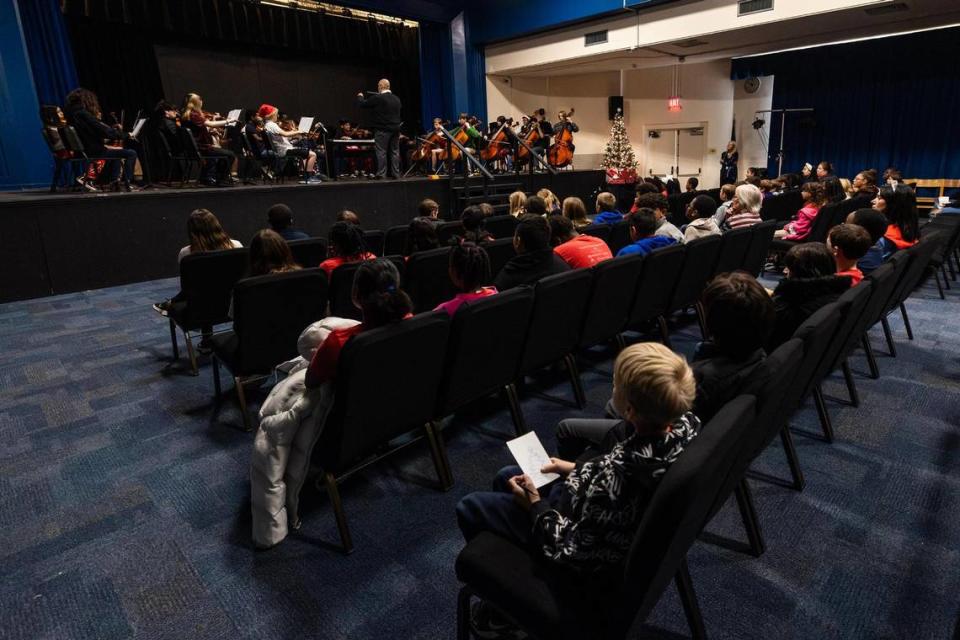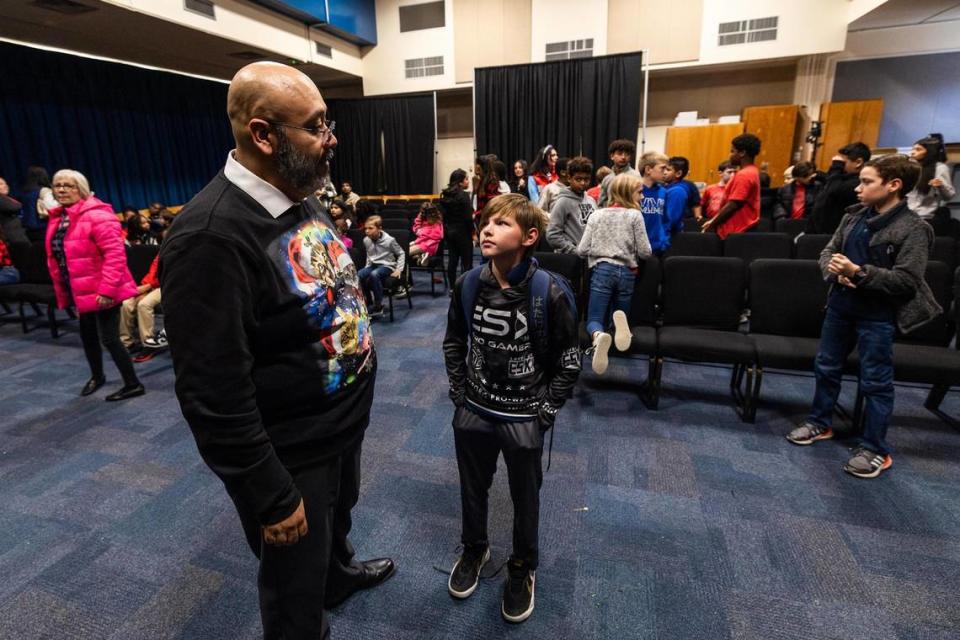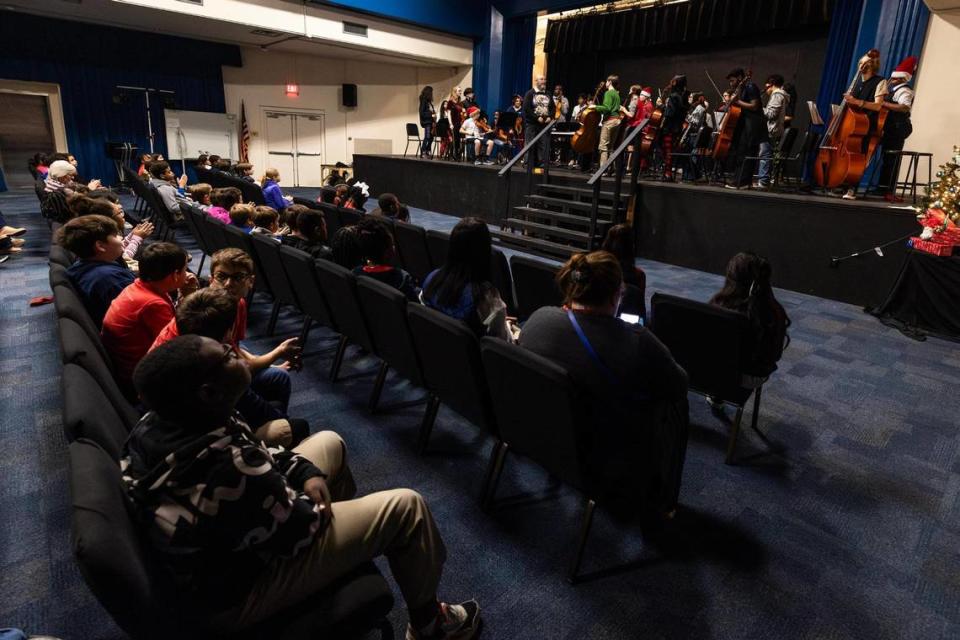Fort Worth ISD schools step up student recruiting as competition from charters grows
About 20 fifth-graders sat in the first few rows of the Applied Learning Academy auditorium Thursday morning, paying varying levels of attention to the middle school musicians on stage in front of them.
Eyes wandered as the basses and cellos played a rhythmic introduction. But about two bars in, when the violins launched into the melody of the English Christmas carol “God Rest Ye Merry,Gentlemen,” ears perked up. A girl sitting at one end of the front row began playfully conducting along with orchestra director Julio Montañez.
After the song ended, Montañez talked with the elementary students about the school’s fine arts programs, which also include band, choir, art and theater. He told them about the academy’s music composition class, where kids learn to write music of their own, ranging in styles from orchestral to hip hop. Then, he told them if any of that sounded interesting, they should go home that evening and apply to enroll in the school.
The fifth-grade students were visitors from Ridglea Hills Elementary School in southwest Fort Worth. The performance doubled as a dress rehearsal for the orchestra’s winter concert and one in a series of recruiting events school leaders hope will help attract students to the middle school.
As competition from charter schools has grown, education researchers say traditional public schools across Texas and nationwide have had to get creative with how they promote themselves to families who have a growing number of choices for where to send their kids to school. For Applied Learning Academy, that means showcasing the programs that make the campus unique, often by putting students front and center, said principal Alice Buckley.
“We need to not just have the expectation that students are going to come to the school because we’re here,” Buckley said.
Schools of choice look to compete with charter schools
Applied Learning Academy is a Fort Worth ISD school of choice, a type of campus that’s sometimes also known as a magnet school. Unlike neighborhood schools, which draw students from areas within designated geographic boundaries, schools of choice enroll students from across the district. Students typically enroll in those schools to participate in certain programs, like fine arts or STEM.
One of the positive things that came out of the pandemic was that parents realized they had choices for their kids’ education, Buckley said — not only through charter schools and private schools, but also online options and homeschooling. As parents began exploring those options, enrollment in traditional school districts declined.
In Fort Worth ISD and many other districts, schools of choice offer many of the same options as charter schools, Buckley said, but if parents don’t know about them, they can’t take advantage of them. So at the beginning of the year, campus leaders at Applied Learning Academy began talking about ways to bring younger students into their building to see what the school had to offer, Buckley said.
It’s a concept Buckley calls authentic recruiting. Rather than hearing a sales pitch, fifth-graders get to come into the school, talk to older students and see what life there is like. It gives them a better chance to picture themselves at the school, she said. And by bringing entire fifth-grade classes to campus, school leaders can show younger kids what they have to offer without asking parents to take a day off work for a tour, she said.
The academy held its first recruiting event last month, when it brought fifth-graders from Alice Contreras Elementary School to campus for the school’s Wellness Day. Some students watched a production of the school’s fall play, while others rotated through wellness-related activities planned by students from the academy’s Blue Zones Wellness Ambassador Advisory team. There were a few hiccups, Buckley said, but everyone seemed to have a good time, and the school saw an uptick in applications for next year.
The academy started its recruiting efforts with Alice Contreras because it’s only a few blocks away, Buckley said, so students can walk between the two. But because Applied Learning Academy is a school of choice, it draws students from across Fort Worth ISD, as well as from charter and private schools. So Buckley said she hopes to expand those efforts next year, inviting fifth-grade classes from elementary schools in all parts of the district to come visit.
Last week’s dress rehearsal is a good example of the authentic recruiting concept, Buckley said. Rather than coming in to see the concert, fifth-graders got to see older kids working with their directors, which is something closer to what they’d do on a typical day at school.
Students who decide to apply to the academy might get a chance to do something similar next year, she said: Every year, students from the school’s music composition advisory class plan out a trip from Fort Worth to Dallas, where they sit in on a Dallas Symphony Orchestra rehearsal. After the rehearsal, students get to talk to the musicians and the conductor about what makes a great piece of music and how composers are able to convey an idea or tell a story without using words.
“It’s a super powerful experience, and those are kind of the seeds that we’re trying to plant with our fifth-grade students,” she said.
Last week’s visit also came at a critical time for recruiting. Fort Worth ISD is in the last few weeks of its application period for schools of choice, so this week represents school leaders’ last chance to make their pitch to prospective students before everyone leaves for the break.
Fifth-graders quiz middle schoolers about life at ALA
While one group of fifth-graders was in the auditorium watching the orchestra Thursday morning, another was in Cathy Gilbride’s social studies classroom, talking to older students about what the school was like. The class listened as three middle school boys performed a rap they wrote to raise money for Presbyterian Night Shelter as a part of a class project. When they were finished, Gilbride told the younger kids that her students would take the money they’d raised to the shelter and tour the facility during an upcoming advisory period.
One fifth-grader asked the middle schoolers to describe a typical day at the school. A boy stood up to walk through the highlights, paying particular attention to the lunch period, when students get to go outside when they’re finished eating, and advisory, when they get to work on projects they’re interested in. Near the end of each grading period, the school schedules daylong advisories, when students get to spend the entire day working on those projects or go on field trips.
When another fifth-grader asked about the school’s math offerings, a middle schooler explained how teachers integrate math into other subjects. For example, in an advisory class focused on cooking, students have to add and subtract fractions and convert tablespoons to cups.
A third fifth-grader asked about the school’s music offerings, saying he played the guitar. Several middle schoolers replied that the music composition advisory would be a good fit, because it gives students the chance to explore a broad range of musical styles.
Fine arts programs can be a key draw for charter schools
Those kinds of special offerings can be one of the main factors that draws families from traditional public schools to charter schools. Keasha Thompson’s daughter, Madison, was a third-grader at De Zavala Elementary School last year. Every day, Madison would finish her work and get bored while she waited for her classmates to finish theirs, Thompson said. Often, Madison would get in trouble for talking because she was bored, she said.
The school also didn’t have many extracurricular activities to keep Madison engaged, Thompson said. So this year, Thompson moved Madison to Rocketship Dennis Dunkins Elementary School, a charter campus in Stop Six.
So far, the school has been a better fit, Thompson said. Madison loves the school’s fine arts programs, and she’s doing better academically because she’s more engaged, she said. She also goes to the school’s after-school program, where teachers are available to help her work through her homework. If De Zavala had offered similar programs, Thompson doubts whether Madison would have left Fort Worth ISD.
“She was literally just going to school and coming home,” Thompson said.
Facing competition, school districts step up recruiting
Across Texas and nationwide, principals and superintendents have had to think harder and differently about the way they sell their schools to their communities, said David DeMatthews, a professor in the College of Education at the University of Texas at Austin. When charter school operators move into a new area and begin spending money on advertising, school district leaders, particularly principals who run schools of choice, often feel as though they have to respond, he said.
In the past, principals would focus on communicating with parents about the programs on their campuses that made them unique, DeMatthews said. But within the past few years, districts have invested more in professional advertising, spending money on things like billboard campaigns and social media marketing in hopes of attracting students and the state revenue that comes with them, he said.
But many of those marketing responsibilities still fall to principals, DeMatthews said. Campus principals have always had a hard job, he said. They serve as instructional leaders in their buildings, working to improve teaching practices and coach young educators. They also handle most communication with parents, keeping them up to date on what’s going on at school and any upcoming deadlines. They also handle day-to-day administrative duties.
Now, on top of those responsibilities, principals also have to promote their campuses, DeMatthews said. They have to handle social media updates, develop their schools’ websites and do outreach to the broader community. That’s especially challenging for principals at schools of choice, which draw students from entire districts, because it means that outreach has to stretch across the entire community rather than a single neighborhood, he said.
DeMatthews and two researchers from St. John’s University in New York published a study in 2021 looking at how principals and district officials in El Paso, New York City and rural Pennsylvania promoted their campuses. Among other things, researchers found that new principals often struggled to balance the marketing aspects of the job with all the other responsibilities that come along with the role. The researchers recommended that district-level administrators take a larger role in those marketing responsibilities, and that colleges of education add courses on educational marketing to help better prepare students for the environment they’ll be working in.
Fort Worth ISD application deadline approaches
Back in the Applied Learning Academy auditorium, Montañez walked a second group of students through the four members of the string section, beginning with the double bass. The two bassists each played short solos so students could hear what it sounded like. Hearing the instrument’s deep, resonant tone, two fifth-grade girls sitting near the back looked at each other and grinned broadly.
Pointing to the second-lowest instrument, Montañez asked if anyone could name it. One student raised her hand.
“Viola?” she asked. No, Montañez said, although it was a good guess. The instrument was a cello. One of the cellists played a few bars of the theme from “Star Wars.”
As the musicians turned in their music to “Carol of the Bells,” the last song in the orchestra’s set, Montañez thanked the Ridglea Hills kids for coming, and encouraged them one last time to apply to enroll at the middle school next year. Before turning back to his orchestra, Montañez told the students that he hoped to see some of them on stage next year.
Fort Worth ISD’s deadline to apply for schools of choice is Jan. 7.







